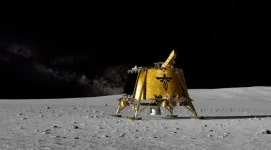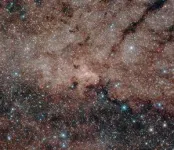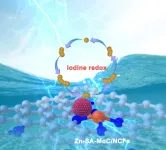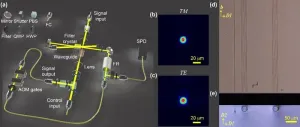(Press-News.org) A NASA X-ray imager is heading to the Moon as part of NASA's Artemis campaign, where it will capture the first global images of the magnetic field that shields Earth from solar radiation.
The Lunar Environment Heliospheric X-ray Imager, or LEXI, instrument is one of 10 payloads aboard the next lunar delivery through NASA’s CLPS (Commercial Lunar Payload Services) initiative, set to launch from the agency's Kennedy Space Center in Florida no earlier than mid-January, with Firefly Aerospace’s Blue Ghost Lander. The instrument will support NASA’s goal to understand how our home planet responds to space weather, the conditions in space driven by the Sun.
Once the dust clears from its lunar landing, LEXI will power on, warm up, and direct its focus back toward Earth. For six days, it will collect images of the X-rays emanating from the edges of our planet’s vast magnetosphere. This comprehensive view could illustrate how this protective boundary responds to space weather and other cosmic forces, as well as how it can open to allow streams of charged solar particles in, creating aurora and potentially damaging infrastructure.
“We’re trying to get this big picture of Earth’s space environment,” said Brian Walsh, a space physicist at Boston University and LEXI’s principal investigator. “A lot of physics can be esoteric or difficult to follow without years of specific training, but this will be science that you can see.”
What LEXI will see is the low-energy X-rays that form when a stream of particles from the Sun, called the solar wind, slams into Earth’s magnetic field. This happens at the edge of the magnetosphere, called the magnetopause. Researchers have recently been able to detect these X-rays in a patchwork of observations from other satellites and instruments. From the vantage point of the Moon, however, the whole magnetopause will be in LEXI’s field of view.
The team back on Earth will be working around the clock to track how the magnetosphere expands, contracts, and changes shape in response to the strength of the solar wind.
“We expect to see the magnetosphere breathing out and breathing in, for the first time,” said Hyunju Connor, an astrophysicist at NASA’s Goddard Space Flight Center in Greenbelt, Maryland, and the NASA lead for LEXI. “When the solar wind is very strong, the magnetosphere will shrink and push backward toward Earth, and then expand when the solar wind weakens.”
The LEXI instrument will also be poised to capture magnetic reconnection, which is when the magnetosphere’s field lines merge with those in the solar wind and release energetic particles that rain down on Earth’s poles. This could help researchers answer lingering questions about these events, including whether they happen at multiple sites simultaneously, whether they occur steadily or in bursts, and more.
These solar particles streaming into Earth’s atmosphere can cause brilliant auroras, but they can also damage satellites orbiting the planet or interfere with power grids on the ground.
“We want to understand how nature behaves,” Connor said, “and by understanding this we can help protect our infrastructure in space.”
s first trip to space. A team at Goddard, including Walsh, built the instrument (then called STORM) to test technology to detect low-energy X-rays over a wide field of view. In 2012, STORM launched into space on a sounding rocket, collected X-ray images, and then fell back to Earth.
It ended up in a display case at Goddard, where it sat for a decade. When NASA put out a call for CLPS projects that could be done quickly and with a limited budget, Walsh thought of the instrument and the potential for what it could see from the lunar surface.
“We’d break the glass — not literally — but remove it, restore it, and refurbish it, and that would allow us to look back and get this global picture that we’ve never had before,” he said. Some old optics and other components were replaced, but the instrument was overall in good shape and is now ready to fly again. “There’s a lot of really rich science we can get from this.”
Under the CLPS model, NASA is investing in commercial delivery services to the Moon to enable industry growth and support long-term lunar exploration. As a primary customer for CLPS deliveries, NASA aims to be one of many customers on future flights. NASA Goddard is a lead science collaborator on LEXI. NASA’s Marshall Space Flight Center in Huntsville, Alabama, manages the development of seven of the 10 CLPS payloads carried on Firefly’s Blue Ghost lunar lander, including LEXI.
Learn more about CLPS and Artemis at:
https://www.nasa.gov/clps
By Kate Ramsayer
NASA’s Goddard Space Flight Center, Greenbelt, Md.
END
NASA’s LEXI will provide X-ray vision of Earth’s magnetosphere
2025-01-03
ELSE PRESS RELEASES FROM THIS DATE:
A successful catalyst design for advanced zinc-iodine batteries
2025-01-03
Aqueous zinc-ion batteries (ZIBs) have attracted extensive attention due to their high safety, abundant reserves, and environmental friendliness. Iodine with high abundance in seawater (55 μg L−1) is highly promising to fabricate zinc-iodine batteries due to high theoretical capacity (211 mAh g−1) and appropriate redox potential (0.54 V). However, the low electrical conductivity of iodine hinders the redox conversion for the efficient energy storage process with zinc. Additionally, the formed soluble polyiodides are prone to migirate to Zn anode, leading to capacity degration and ...
AMS Science Preview: Tall hurricanes, snow and wildfire
2025-01-03
The American Meteorological Society continuously publishes research on climate, weather, and water in its 12 journals. Many of these articles are available for early online access–they are peer-reviewed, but not yet in their final published form.
Below is a selection of articles published early online recently. Some articles are open-access; to view others, members of the media can contact kpflaumer@ametsoc.org for press login credentials.
JOURNAL ARTICLES
The Impact of Snowoff Timing and Associated Atmospheric Drivers on the Alaska Wildfire Season
Earth Interactions
Earlier ...
Study finds 25% of youth experienced homelessness in Denver in 2021, significantly higher than known counts
2025-01-03
AURORA, Colo. (Jan. 3, 2025) – A first of its kind study, published today in Pediatrics, has provided full-picture assessment of youth homelessness in Denver, Colorado. The findings reveal that nearly 25% of youth in Denver experienced homelessness or housing insecurity in 2021, with rates increasing almost every year since 2017.
Researchers across Colorado, led by Josh Barocas, MD and resident Matthew Westfall, MD of the University of Colorado Anschutz Medical Campus, combined multiple data sources for youth aged 14 to 17 in the City of Denver, to estimate the total number ...
Integrated spin-wave quantum memory
2025-01-03
The synchronization function of quantum memories can be employed to connect multiple short-distance entanglement into long-distance entanglement, so that to effectively overcome the transmission loss of photons and enable the construction of large-scale quantum networks. The rare-earth ions doped crystals is a candidate system for implementation of quantum memories with excellent performances, and integrated solid-state quantum memories have been successfully demonstrated with various micro- and nano- fabrication techniques.
All previous demonstrations of integrated quantum memories for light are limited to the storage ...
Brain study challenges long-held views about Parkinson's movement disorders
2025-01-03
University of Arizona researchers have revealed new insights into one of the most common complications faced by Parkinson's disease patients: uncontrollable movements that develop after years of treatment.
Parkinson's disease – a neurological disorder of the brain that affects a person's movement – develops when the level of dopamine, a chemical in the brain that's responsible for bodily movements, begins to dwindle. To counter the loss of dopamine, a drug called levodopa is administered and later gets converted into dopamine in the brain. However, long-term treatment with levodopa induces ...
Mental disorders among offspring prenatally exposed to systemic glucocorticoids
2025-01-03
About The Study: In this cohort study, prenatal exposure to glucocorticoids was associated with higher risk of some mental disorders. These data support continued caution in the use of glucocorticoids in pregnant people.
Corresponding Author: To contact the corresponding author, Kristina Laugesen, PhD, email kristina.laugesen@clin.au.dk.
To access the embargoed study: Visit our For The Media website at this link https://media.jamanetwork.com/
(doi:10.1001/jamanetworkopen.2024.53245)
Editor’s Note: Please see the article for additional information, including other authors, author contributions ...
Trends in screening for social risk in physician practices
2025-01-03
About The Study: In this survey-based cross-sectional study of U.S. physician practices, social risk screening increased substantially from 2017 to 2022, although still less than one-third of practices systematically screened for a set of 5 common social risks (food, housing, utilities, interpersonal violence, and transportation). What remains to be seen is whether practices use these data to help improve patient health by adjusting health care or referring patients for assistance with social needs. As policies and incentives increasingly emphasize social risk screening, it will be important to assess the association of screening and referrals with patient ...
Exposure to school racial segregation and late-life cognitive outcomes
2025-01-03
About The Study: This cross-sectional study of Black and white older individuals found that childhood exposure to school segregation was associated with late-life cognition among the Black population. Given the increasing amount of school segregation in the U.S., educational policies aimed at reducing segregation are needed to address health inequities. Clinicians may leverage patients’ early-life educational circumstances to promote screening, prevention, and management of cognitive disorders.
Corresponding Author: To contact the corresponding author, Xi Chen, PhD, email xi.chen@yale.edu.
To ...
AI system helps doctors identify patients at risk for suicide
2025-01-03
A new study from Vanderbilt University Medical Center shows that clinical alerts driven by artificial intelligence (AI) can help doctors identify patients at risk for suicide, potentially improving prevention efforts in routine medical settings.
A team led by Colin Walsh, MD, MA, associate professor of Biomedical Informatics, Medicine and Psychiatry, tested whether their AI system, called the Vanderbilt Suicide Attempt and Ideation Likelihood model (VSAIL), could effectively prompt doctors in three neurology clinics at VUMC to screen patients for suicide risk during regular clinic visits.
The study, reported in JAMA Network Open, compared two approaches — automatic ...
Advanced imaging uncovers hidden metastases in high-risk prostate cancer cases
2025-01-03
A new study led by researchers at the UCLA Health Jonsson Comprehensive Cancer Center has found that many cases of high-risk nonmetastatic hormone-sensitive prostate cancer may be more advanced than previously thought.
The study, published in JAMA Network Open, found that nearly half of high-risk prostate cancer patients previously classified as nonmetastatic by conventional imaging actually have metastatic disease when evaluated with advanced prostate-specific membrane antigen–positron emission tomography (PSMA-PET) ...




